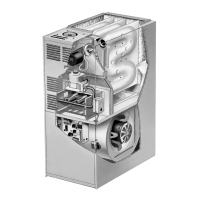3DJH
II-PLACEMENT AND INSTALLATION
Make sure unit is installed in accordance with installation
instructions and applicable codes.
A-Fresh Air Requirements
Until recently, there was no problem in bringing in sufficient
amounts of outdoor air for combustion -- infiltration provided
all the air that was needed and then some. In today’s homes
built with energy conservation in mind, tight construction prac-
tices make it necessary to bring in air from outside for com-
bustion. Consideration must also be given to the use of ex-
haust fans, appliance vents, chimneys and fireplaces be-
cause they draw additional air that could be used for combus-
tion out of the house. Unless outside air is brought into the
home for combustion, negative pressure (pressure outside is
greater than inside pressure) will build to the point that a down
draft can occur in the furnace vent pipe or chimney. Combus-
tion gases can enter the living space creating a potentially
dangerous situation.
Theimportanceof the previousparagraphcannot beover-
stated. Users may inadvertently block fresh air intakes af-
ter installation.
In the absence of local codes concerning air for combustion
and ventilation, the following section outlines guidelines and
recommends procedures for operating G23(X) furnaces in a
manner that ensures efficient and safe operation. Special
consideration must be given to combustion air needs as well
as requirements for exhaust vents and gas piping. A portion
of this information has been reprinted with permission from
the National Fuel Gas Code (ANSI-Z223.1). This reprinted
material is not the complete and official position of the ANSI
on the referenced subject, which is represented only by the
standard in its entirety.
In Canada, refer to the standard CAN/CGA-B149.1 and -
B149.2 installation codes.
Combustion Air Requirements
&$87,21
Insufficient combustion air can cause headaches,
nausea, dizziness or asphyxiation. Excessive ex-
posure to contaminated combustion air will result
in safety and performance related problems.
Avoid exposure to the following substances in the
combustion air supply:
Permanent wave solutions;
Chlorinated waxes and cleaners;
Chlorine base swimming pool chemicals;
Water softening chemicals;
De-icing salts or chemicals;
Carbon tetrachloride;
Halogen type refrigerants;
Cleaning solvents (such as perchloroethylene);
Printing inks, paint removers, varnishes, etc.;
Hydrochloric acid;
Cements and glues;
Antistatic fabric softeners for clothes dryers; and
Masonry acid washing materials.
All gas-fired appliances require air to be used for the com-
bustion process. If sufficient amounts of combustion air are
not available, the furnace or other appliance will operate in
an inefficient and unsafe manner. Enough air must be pro-
vided to meet the needs of all fuel-burning appliances, as
well as appliances such as exhaust fans which force air out
of the home. When fireplaces, exhaust fans, or clothes dry-
ers are used at the same time as the furnace, much more air
is required to ensure proper combustion and to prevent a
down-draft situation. Insufficient amounts of air also cause
incomplete combustion which can result in carbon monox-
ide. The requirements for providing air for combustion and
ventilation depend largely on whether the furnace is installed
in an unconfined or confined space.
Unconfined Space
An unconfined space is an area such as a basement or
large equipment room with a volume greaterthan 50cubic
feet per 1,000 Btu per hour of the combined input rating of
all appliances installed in that space. This space also in-
cludes adjacent rooms which are not separated by a door.
Though an area may appear to be unconfined, it might be
necessary to bring in outdoor air for combustion if the
structure does not provide enough air by infiltration. If the
furnace is located in a building of tight construction with
weather stripping and caulking around the windows and
doors, follow the procedures outlined for usingair from the
outside for combustion and ventilation.
Confined Space
A confined space is an area with volume less than 50 cubic
feet per 1,000 Btu per hour of the combined input rating of all
appliances installed in that space. This definition includes
furnace closets or small equipment rooms.
